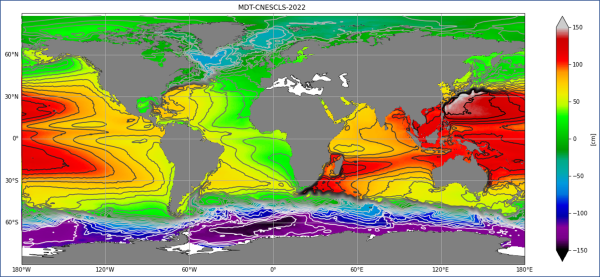The Combined Mean Dynamic Topography MDT CNES-CLS2022
The point of estimating a global Mean Dynamic Topography (MDT) is to reference the altimeter Sea Level Anomalies (SLA), in order to obtain the full signal that results from the dynamic of the ocean : the Absolute Dynamic Topography (ADT).
The method estimates the mean over the period 1993-2012 but is not limited to observations from this period (method to correct for ocean variability).
Note that the Ssalto/Duacs (M)SLA products are computed relative to 1993-2012 period since April 2014 (Duacs 2014 v15.0 version and posterior version). Thus it is mandatory to be consistent and use (M)SLA and MDT referenced to the same time period.
- We first compute a first guess: a medium scale of Mean Dynamic Topography using only satellite data (gravimetry and altimetry). The raw difference of Mean Sea Surface with geoid model is filtered using an optimal filter to remove noise and residual geodetic signal.
- Beside we compute synthetic estimate of MDT and mean geostrophic current from oceanic in-situ data (T/S profiles and drifters).
- First, the data are processed to have the same physical content as altimetry:
- the drifters (SVP and Argo drifting at the surface) are processed to only extract the geostrophic component
- also deep baroclinic and barotropic components are added to dynamic height computed from T/S profiles.
- Then sea level anomalies are interpolated and subtracted from in-situ measurements of the ocean state to estimate a mean: MDT and the corresponding mean geostrophic surface velocities.
- First, the data are processed to have the same physical content as altimetry:
- Then, using a multivariate objective analysis, the synthetic estimates of mean heights and mean velocities are combined to improve the first guess of the MDT.
- Finally, a validation is done by comparing this version to other MDTs and independent in-situ data.
The Table below lists the input data and improvement done for the new CNES-CLS2022 compared with the previous CNES-CLS18.
| MDT CNES-CLS2022 | MDT CNES-CLS18 | ||
|---|---|---|---|
| First guess | MSS used | CNES-CLS22 (Schaeffer et al., 2022) | CNES-CLS15 (Pujol et al, 2018) |
| Geoïd | GOCO06S (Kvas, A. et al, 2021) Complete GOCE mission fully reprocessed (Nov 2009-October 2013) + 14 years of GRACE data | GOCO05S (Mayer-Gürr,et al. 2015) Complete GOCE mission (Nov 2009-October 2013) + 10.5 years of GRACE data | |
| First Guess filtering | Optimal filter (Rio et al, 2011) + lagrangian filter along the coast to avoid streamline going into land | Optimal filter (Rio et al, 2011) with updated parameters | |
| Synthetic estimate from in-situ data | Hydrological data | CTD and ARGO Pref variable 200/400/900/1200/1900 from CMEMS CORA Release 202212 Period 1993-2020 | CTD and ARGO Pref variable 200/400/900/1200/1900 from CORA4.2 (1993-2013), CORA5.0 (2014-2015) and CORA5.1 (2016) Period 1993-2016 |
| Drifter Data | SD-DAC drifter, both drogued and undrogued: 1993-2021 Argo floats surface velocities: 1997-2021 | SD-DAC drifter, both drogued and undrogued: 1993-2016 Argo floats surface velocities: 1997-2016 | |
| High Frequency Radar Data | 2006-2016 Mean HF radar currents processed by Rutgers University (Roarty et al 2020) in Mid atlantic Bight | ||
| Ekman model | Parameters fitted over the period 1993-2021 by latitude and Mixed Layer Depth (from ARMOR3D) Two levels: 0m and 15m | Parameters fitted over the period 1993-2016 by latitude and Mixed Layer Depth (from ARMOR3D) Two levels: 0m and 15m | |
| Wind Slippage correction | Update of Rio et al, 2012 in order not to discard the trajectories beginning/end | Update of Rio et al, 2012 in order not to discard the trajectories beginning/end | |
| Drifter filtering | Max (24 hours, Inertial Period) | Max (24 hours, Inertial Period) | |
| Altimeter data | Delayed-Time CMEMS-DUACS 2021 (Taburet et al., 2022) | Delayed-Time CMEMS-DUACS 2018 (Taburet et al, 2019) | |
| Inversion | Resolution | Global 1/8° | Global 1/8° |
References:
- Kvas, Andreas, Jan Martin Brockmann, Sandro Krauss, Till Schubert, Thomas Gruber, Ulrich Meyer, Torsten Mayer-Gürr, Wolf-Dieter Schuh, Adrian Jäggi, et Roland Pail. « GOCO06s – a Satellite-Only Global Gravity Field Model ». Earth System Science Data 13, no 1 (27 janvier 2021): 99118. https://doi.org/10.5194/essd-13-99-2021.
- Mayer-Gürr, T., Pail, R., Gruber, T., Fecher, T., Rexer, M., Schuh, W.-D., Kusche, J., Brockmann, J.-M., Rieser, D., Zehentner, N., Kvas, A., Klinger, B., Baur, O., Höck, E., Krauss, S., and Jäggi, A.: The combined satellite gravity field model GOCO05s, presented at OSTST, Vienna, Austria, 2015.
- Pujol et al., Gauging the Improvement of Recent Mean Sea Surface Models: A New Approach for Identifying and Quantifying Their Errors, J. Geophys. Res. Oceans, 123, 5889–5911, https://doi.org/10.1029/2017JC013503 , 2018
- Rio, M. H., S. Guinehut, et G. Larnicol. « New CNES-CLS09 Global Mean Dynamic Topography Computed from the Combination of GRACE Data, Altimetry, and in Situ Measurements ». Journal of Geophysical Research: Oceans 116, no C7 (2011). https://doi.org/10.1029/2010JC006505.
- Rio, M.-H. « Use of Altimeter and Wind Data to Detect the Anomalous Loss of SVP-Type Drifter’s Drogue ». Journal of Atmospheric and Oceanic Technology 29, no 11 (1 novembre 2012): 166374. https://doi.org/10.1175/JTECH-D-12-00008.1.
- Roarty, Hugh, Scott Glenn, Joseph Brodie, Laura Nazzaro, Michael Smith, Ethan Handel, Josh Kohut, et al. « Annual and Seasonal Surface Circulation Over the Mid-Atlantic Bight Continental Shelf Derived From a Decade of High Frequency Radar Observations ». Journal of Geophysical Research: Oceans 125, no 11 (2020): e2020JC016368. https://doi.org/10.1029/2020JC016368.
- Schaeffer et al., New CNES CLS 2022 mean sea surface, OSTST 2022, https://doi.org/10.24400/527896/a03-2022.3310
- Taburet et al., DUACS DT2021: 28 years of reprocessed sea level altimetry products, OSTST 2022, https://doi.org/10.24400/527896/a03-2022.3257
- Taburet et al., DUACS DT2018: 25 years of reprocessed sea level altimetry products, Ocean Science, 15, 1207–1224, https://doi.org/10.5194/os-15-1207-2019 , 2019.






